THE COST OF STYLE
Page 31
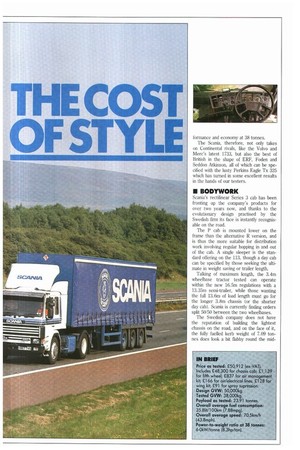
Page 32
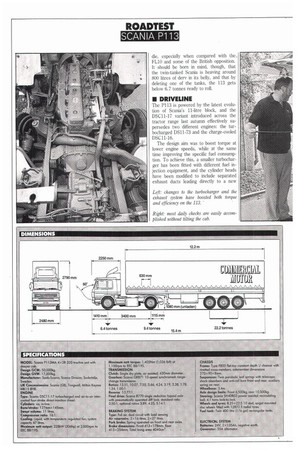
Page 33
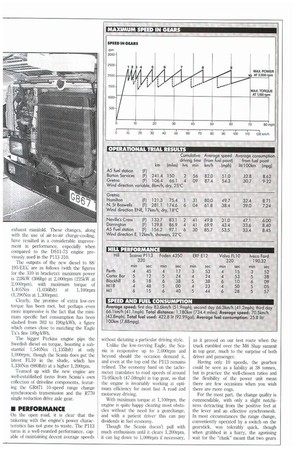
Page 34
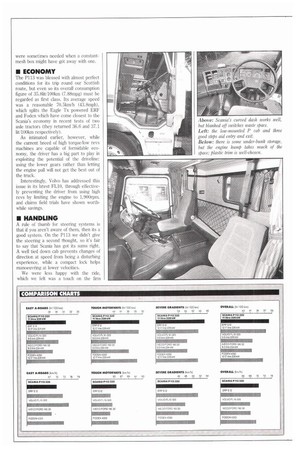
Page 35
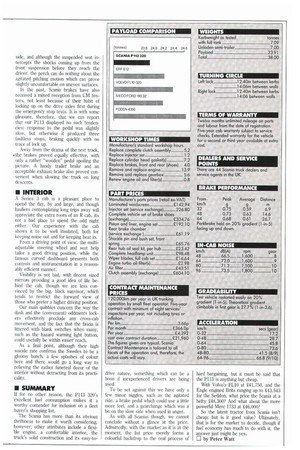
If you've noticed an error in this article please click here to report it so we can fix it.
formance and economy at 38 tonnes.
The Scania, therefore, not only takes on Continental rivals, like the Volvo and Merc's latest 1733, but also the best of British in the shape of ERF, Foden and Seddon Atkinson, all of which can be specified with the lusty Perkins Eagle Tx 325 which has turned in some excellent results in the hands of our testers.
Scania's rectilinear Series 3 cab has been fronting up the company's products for over two years now, and thanks to the evolutionary design practised by the Swedish firm its face is instantly recognisable on the road.
The P cab is mounted lower on the frame than the alternative R version, and is thus the more suitable for distribution work involving regular hopping in and out of the cab. A single sleeper is the standard offering on the 113, though a day cab can be specified by those seeking the ultimate in weight saving or trailer length.
Talking of maximum length, the 3.4m wheelbase tractor tested can operate within the new 16.5m regulations with a 13.35m semi-trailer, while those wanting the full 13.6m of load length must go for the longer 3.8m chassis for the shorter day cab). Scania is currently finding orders split 50/50 between the two wheelbases.
The Swedish company does not have the reputation of building the lightest chassis on the road, and on the face of it, the fully fuelled kerb weight of 7.09 tonnes does look a bit flabby round the mid
die, especially when compared with the. FL10 and some of the British opposition. It should be born in mind, though, that the twin-tanked Scania is heaving around 800 litres of dery in its belly, and that by • deleting one of the tanks, the 113 gets below 6.7 tonnes ready to roll.
The P113 is powered by the latest evolution of Scania's 11-litre block, and the DSC11-17 variant introduced across the tractor range last autumn effectively supersedes two different engines: the turbocharged DS11-73 and the charge-cooled DSC11-16.
The design aim was to boost torque at lower engine speeds, while at the same time improving the specific fuel consumption. To achieve this, a smaller turbocharger has been fitted with different fuel injection equipment, and the cylinder heads have been modified to include separated exhaust ducts leading directly to a new Left: changes to the turbocharger and the exhaust system have boosted both torque and efficiency on the 113.
Right: most daily checks are easily accomplished without tilting the cab.
exhaust manifold. These changes, along with the use of air-to-air charge-cooling, have resulted in a considerable improvement in performance, especially when compared to the DS11-73 engine previously used in the P113 310.
The outputs of the new diesel to 88/ 195/EEC are as follows (with the figures for the 310 in brackets): maximum power is 228kW (306hp) at 2,000rpm (225kW at 2,000rpm), with maximum torque of 1,405Nm (1,036lbft) at 1,100rpm (1,290Nm at 1,300rpm).
Clearly, the promise of extra low-rev torque has been met, but perhaps even more impressive is the fact that the minimum specific fuel consumption has been slashed from 203 to 190g/kWh, a figure which comes close to matching the Eagle Tx's fine 189g/kWh.
The bigger Perkins engine pips the Swedish diesel on torque, boasting a substantial 1,540Nm (1,1351bft) at only 1,000rpm, though the Scania does put the latest FL10 in the shade, which has 1,330Nm (980Ibft) at a higher 1,200rpm.
Teamed up with the new engine are well-established items from Scania's own collection of driveline components, featuring the GR871 10-speed range change synchromesh transmission and the R770 single reduction drive axle gear.
On the open road, it is clear that the tinkering with the engine's power characteristics has not gone to waste. The P113 turns in a well-rounded performance, capable of maintaining decent average speeds
without dictating a particular driving style.
Unlike the low-revving Eagle, the Scania is responsive up to 2,000rpm and beyond should the occasion demand it, and even at the top end the P113 remains refined. The economy band on the tachometer translates to road speeds of around 75-95kmth (47-59mph) in top gear, so that the engine is invariably working at optimum efficiency for most fast A road and motorway driving.
With maximum torque at 1,100rpm, the engine is quite happy clearing most obstacles without the need for a gearchange, and with a patient driver this can pay dividends in fuel economy.
Though the Scania doesn't pull with much enthusiasm until it clears 1,200rpm, it can lug down to 1,000rpm if necessary, as it proved on our test route when the truck rumbled over the M6 Shap summit in top gear, much to the surprise of both driver and passenger.
Having only 10 speeds, the gearbox could be seen as a liability at 38 tonnes, but in practice the well-chosen ratios and the flexibility of the power unit mean there are few occasions when you wish there are more cogs.
For the most part, the change quality is commendable, with only a slight notchiness detracting from the positive feel at the lever and an effective synchromesh. In most circumstances the range change, conveniently operated by a switch on the gearstick, was tolerably quick, though when grabbed in a hurry, the agonising wait for the "clunk" meant that two gears
The P113 was blessed with almost perfect conditions for its trip round our Scottish route, but even so its overall consumption figure of 35.8lit/100km (7.88mpg) must be regarded as first class. Its average speed was a reasonable 70.5km/h (43.8mph), which splits the Eagle Tx powered ERF and Foden which have come closest to the Scania's economy in recent tests of two axle tractors (they returned 36.6 and 37.1 lit1100km respectively).
As intimated earlier, however, while the current breed of high torque/low revs machines are capable of formidable economy, the driver has a big part to play in exploiting the potential of the driveline: using the lower gears rather than letting the engine pull will not get the best out of the truck.
Interestingly, Volvo has addressed this issue in its latest FL10, through effectively preventing the driver from using high revs by limiting the engine to 1,900rpm, and claims field trials have shown worthwhile savings.
A rule of thumb for steering systems is that if you aren't aware of them, then its a good system. On the P113 we didn't give the steering a second thought, so it's fair to say that Scania has got its sums right. A well tied down cab prevents changes of direction at speed from being a disturbing experience, while a compact lock helps manoeuvring at lower velocities.
We were less happy with the ride, which we felt was a touch on the firm
side, and although the suspended seat intercepts the shocks coming up from the front suspension before they reach the driver, the perch can do nothing about the agitated pitching motion which can prove slightly uncomfortable on uneven surfaces.
In the past, Scania brakes have also received a mixed reception from CM testers, not least because of their habit of locking up on the drive axles first during the emergency stop tests. It is with some pleasure, therefore, that we can report that our P113 displayed no such tendencies: response to the pedal was slightly slow, but otherwise it produced three faultless stops, braking quickly with no trace of lock up.
Away from the drama of the test track, • the brakes proved equally effective, with only a rather "wooden" pedal spoiling the picture. A handy trailer brake and an acceptable exhaust brake also proved convenient when slowing the truck on long descents.
A Series 3 cab is a pleasant place to spend the day, by and large, and though hauliers contemplating long trips away will appreciate the extra room of an R cab, its not a bad place to spend the odd night either. Our experience with the cab shows it to be well insulated, both for keeping noise out and for keeping heat in From a driving point of view, the multiadjustable steering wheel and seat help tailor a good driving position, while the famous curved dashboard presents both controls and instrumentation in a reasonably efficient manner.
Visibility is not bad, with decent sized min-oPs providing a good idea of life behind the cab, though we are less convinced by the big, black sunvisor, which tends to restrict the forward view of those who prefer a higher driving position.
Our main quibbles concern the way the dash and the (convenient) oddments lockers effectively preclude any cross-cab movement, and the fact that the fascia is littered with blank switches when many, such as the hazard warning light button, could usefully be within easier reach.
As a final point, although their high suicide rate confirms the Swedes to be a gloomy bunch, a few splashes of colour here and there would go a long way to relieving the rather funereal decor of the interior without detracting from its practicality.
If for no other reason, the P113 320's excellent fuel consumption makes it a worthy contender for inclusion on a fleet buyer's shopping list.
The Scania has more than its obvious thriftiness to make it worth considering, however; other attributes include a flexible engine, a comfortable interior, the truck's solid construction and its easy-to
drive nature, something which can be a boon if inexperienced drivers are being used.
To be set against this we have only a few minor niggles, such as the agitated ride, a brake pedal which could use a little more feel, and a gearchange which was a bit on the slow side when used in anger.
As with all Scanias though, we cannot conclude without a glance at the price. Admittedly, with the market as it is at the moment, the list price merely forms a colourful backdrop to the real process of hard bargaining, but it must be said that the P113 is anything but cheap.
With Volvo's FL10 at 241,750, and the Eagle engined Brits ranging up to £43,543 for the Seddon, what price the Scania at a hefty 248,300? And what about the more powerful Merc 1733 at V16,000?
So the latest tractor from Scania isn't cheap; but is it good value? Ultimately, that is for the market to decide, though if fuel economy has much to do with it, the answer just might be yes.
by Peter Watt




















































































